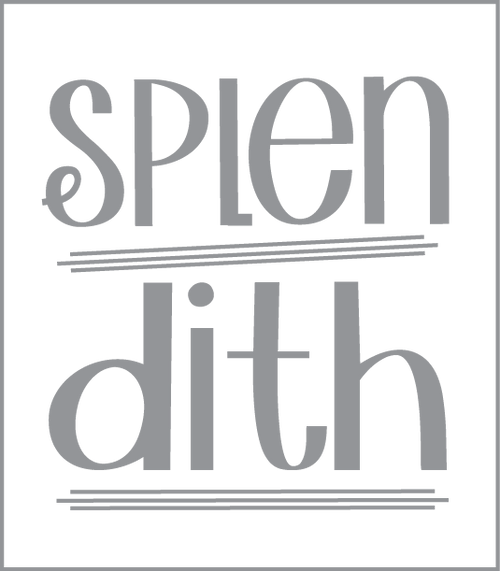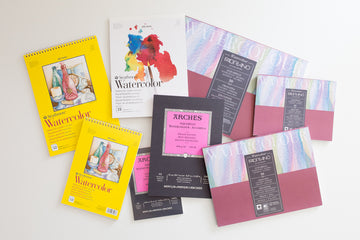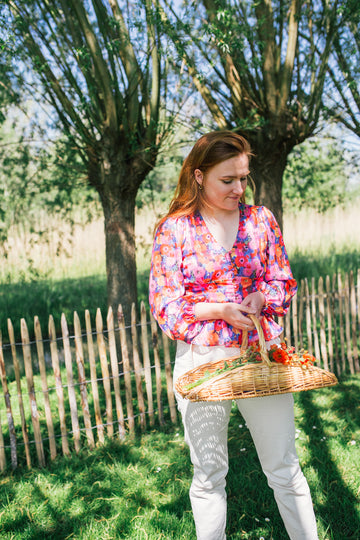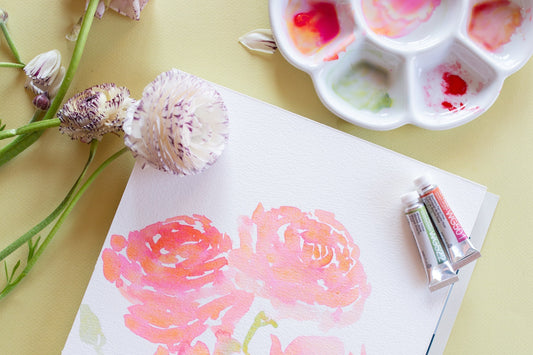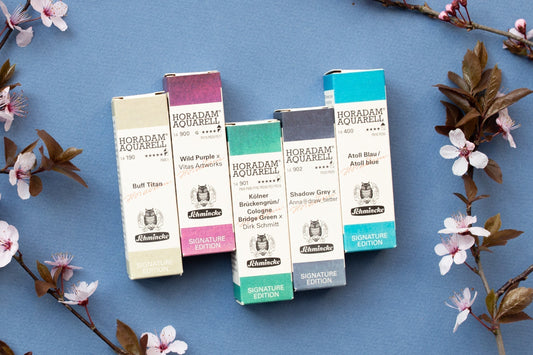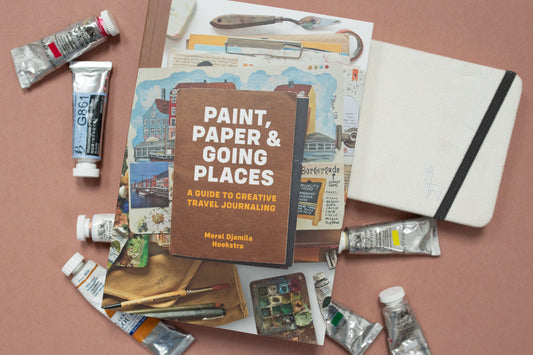Het assortiment in de shop wordt steeds groter, net als de kans op keuzestress ;). Duurder hoeft niet altijd beter te zijn en de favoriet van jouw inspiratiebron is niet perse jouw go to. Om je wat op weg te helpen bij je materiaalkeuze ga ik elke week over een artikel schrijven. Dit kan zijn over de specificaties van één specifiek artikel, hoe je dat moet gebruiken. Of bijvoorbeeld een vergelijking van verschillende materialen. Hiervan komt minstens één blog per week online. Ik begin de reeks met informatie over aquarelpapier.

Verschillen in Aquarelpapier
Het is zo lastig om papier van internet te kopen! Of van een verpakking terwijl je het papier niet kan voelen. Door te voelen kan je al snel de kwaliteit inschatten. Er zijn best wat tricks om te kunnen bepalen of de kwaliteit van het papier goed is of dat de papiersoort bij je past. In deze blog ga ik het proberen uit te leggen. Er zijn een aantal termen waarin de kwaliteit van papier wordt aangeduid. Omdat er zoveel papiersoorten zijn, worden deze termen ook altijd netjes vermeld! Deze heb je ongetwijfeld al voorbij zien komen. Ik leg je de volgende termen uit:
- Cold and hot pressed
- Student vs Artist quality
- Gewicht
- Acid free
- Ph neutraal
- Materiaal: Katoen vs cellulose
 Cold vs Hot pressed Aquarelpapier
Cold vs Hot pressed Aquarelpapier
Het grootste verschil bij Aquarelpapier zit in hot of cold pressed papier. Hot pressed is altijd heel glad, denk bij hot aan heet/strijken. Bij Cold pressed papier zit meer structuur in het papier. Ik heb de foto met opzet wat donkerder gelaten, hopelijk kan je zo goed de structuur van het papier zien.
Hot pressed aquarelpapier:
In hot pressed papier (links op deze foto) zit dus bijna geen stuctuur. Deze soort aquarelpapier is het beste geschikt voor gedetaileerd werk. Ook hoef je geen rekenig te houden met dat de inkt of verf door de stuctuur verloopt. Omdat er minder structuur in het papier zit, zuigt het papier ook minder verf/water op. De inkt droogt dus minder snel, waardoor je meer tijd overhoudt om met de verf te spelen. Omdat er geen structuur in het papier zit, heb je geen last van schaduwwerking. Hierdoor lijken de kleuren die je hebt gebruikt nog helderder.
Cold pressed aquarelpapier
Bij Cold pressed papier (rechts op deze foto) krijg je een stuctuur in het papier. De structuur kan per papiersoort verschillen. De structuur wordt aangeduid in ****. Het papier kan door deze structuur meer en sneller water opnemen. Over het algemeen wordt dit type aquarelpapier het meeste gebruikt en aangeraden voor beginners.
Student vs Artist quality
Je hebt de termen student en artist waarschijnlijk wel voorbij zien bij de materialen die je gebruikt. Deze termen verwijzen naar de kwaliteit van de materialen. Student kwaliteit is wat goedkoper omdat de kwaliteit daar ook naar is. Er worden net andere materialen en technieken gebruikt, waardoor het papier goedkoper kan zijn. Dit type papier is prima voor experimenten en basic aquarellen. Artist grade is vanzelfsprekend wat duurder omdat de kwaliteit ook beter is. Bij aquarel papier uit zich dat verschil vooral in het gebruik van de hoeveelheid water. Bij Artist grade papier heb je minder beperkingen in het papier en kan je het echt tot de max van z’n kunnen gebruiken.
Gewicht
De dikte van het papier is gekoppeld aan de hoeveelheid water het papier kan opnemen. 240-300 grams papier zorgt er ook voor dat je papier niet meteen krom trekt zodra je flink wat water gebruikt. Wat dunner papier is vaak goedkoper en weer prima om op te oefenen.
De grammage van papier is het gewicht dat papier per vierkante meter heeft. Het is dus niet 300 gram per pagina. Bijvoorbeeld; Koop je een blok papier met 300gm papier, dan maakt het de dikte van het papier geen verschil bij een blok van 10x15 of 20x30.

Acid free & Ph neutraal
Acid free en Ph Neutraal papier is altijd aan te raden, dit papier verkleurd niet als het lang aan zonlicht wordt blootgesteld.
Materiaal: Katoen vs cellulose
De meest voorkomende materialen die gebruikt worden zijn cellulose en katoen. Hetzelfde geldt voor Aquarelpapier. Papier met katoen neemt het meeste water op.
En een laatste opmerking: je hebt aquarelpapier in verschillende tinten wit. Bijvoorbeeld; extra wit, natuurlijk wit, wit en creme. De standaard is wit en is de kleur afwijkend dan wordt dit aangegeven.
Welke soorten aquarelpapier verkoop ik? Ik verkoop de fijnste merken aquarelpapier; Arches, Fabriano en Strathmore. Ze vallen allemaal in andere prijsklasse, dus voor iedereen een passende soort papier.
Om even kort de verschillen van het aquarelpapier uit de shop te nomen: Strathmore 200 is de meest budgetvriendelijke versie, Arches is Hot Pressed(Artist), Fabriano is wat dunner papier van Artist kwaliteit, Strathmore 300 is dik aquarelpapier met een handige ringband.
Heb je nog vraagjes? Stel ze vooral in de comments, ik probeer ze altijd zo snel mogelijk te beantwoorden!
Liefs,
Judith
